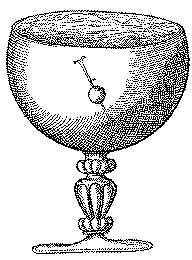|
[an error occurred while processing this directive]
5. What was known before Gilbert |
[an error occurred while processing this directive]
|
Review #1 Review #2 |
The early Chinese also knew about lodestones and about iron magnetized by them. Around the year 1000 they discovered that when a lodestone or an iron magnet was placed on a float in a bowl of water, is always pointed south. From this developed the magnetic compass, which quickly spread to the Arabs and from them to Europe. The compass helped ships navigate safely, even out of sight of land, even when clouds covered the stars. Compasses were also built into portable sundials, whose pointers had to face north to give the correct time. The nature of magnetism and the strange directional properties of the compass were a complete mystery. For instance, no garlic was allowed on board ships, in the mistaken belief that its pungent fumes caused the compass to malfunction. Columbus felt the compass needle was somehow attracted by the pole star, which maintained a fixed position in the northern sky while the rest of the heavens rotated around it.
|
|
And second, the force on the needle was not horizontal but slanted downwards into the Earth. If a compass needle was balanced evenly on its pivot before being magnetized, then afterwards its north end would be pulled downwards, and a tip had to be snipped off to restore balance. This was studied by Robert Norman of London, England, who was drawn to investigate this, after snipping off too much of a needle he was preparing, and spoiling it. In 1581 he published his finding in a book, The Newe Attractive. |
|
Norman used a compass needle balanced on a horizontal axis, able to swing in a vertical plane lined up in the north-south direction. That way, the north pointing end of the needle could still point northwards, and it did so, but it was no longer horizontal. Instead it slanted downwards at a steep "dip angle." This demonstrated that the magnetic force was not horizontal, either.
Next Stops: 1. A review of "De Magnete" 2. Another review of "De Magnete"
About the Background: 6. London in 1600
Further reading: The Riddle of the Compass by Amir D. Aczel is a popular book on the introduction of the compass to navigation (before 1600) and the history surrounding it; xvii + 178pp, Harcourt Inc. 2001. Back to the Master List |
Author and Curator: Dr. David P. Stern
Mail to Dr.Stern: earthmag("at" symbol)phy6.org
Last updated 25 November 2001
Re-formatted 18 March 2006

